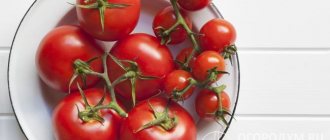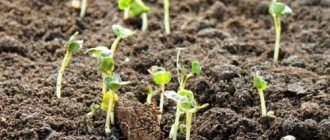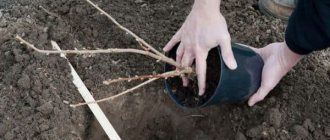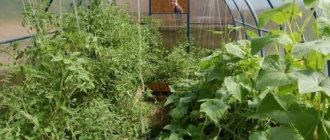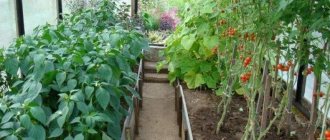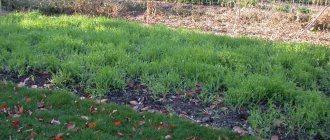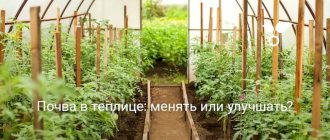Yesterday, October 13, we finally cleaned the greenhouse, removed all the cucumber vines (the tomatoes were pulled out earlier) and the lettuce, which continued to grow well. After this, the entire internal surface was thoroughly washed with a disinfectant solution. All that remains is to carefully dig up the soil with wood ash, which we have stored in abundance.
Radish in a greenhouse
Read on dacha6.ru:
Should greenhouse doors be closed for the winter?
When to throw snow into a greenhouse
Interestingly, in the middle of the week the last 12 greens of the season were collected. They were all small, about the length of an index finger and the same thickness.
Planting our favorite white mustard in mid-October is clearly too late. Then what, should we leave the greenhouse for the winter as is, until the start of the next season? There is a more interesting option!
How to prepare soil in a greenhouse in the fall
At the end of October - beginning of November, when persistent frosts come to central Russia, some crops can be sown before winter in an unheated polycarbonate greenhouse.
Again, you need to dig up the soil properly, while adding organic (up to 5 kg per 1 m2) and mineral fertilizers (1 tbsp per 1 m2), and ash (1 cup per 1 m2). After digging, carefully level the surface with a garden rake. During the procedure, remove all found plant residues from the soil.
When the preparatory part is completed, it is necessary to make grooves and plant.
What then can you plant the table?
Crop rotation - what can or cannot be planted after that - table
| THE CULTURE WE PLANT | BEST PRECEDORS | NOT AFTER... |
| Spinach | Tomatoes, cabbage, radishes, potatoes | Pumpkin, beets, lettuce |
| Wheat, rye, oats, corn | Barley | |
| Leek | Legumes, cabbage, potatoes | Onions |
Interesting materials:
How to dress your baby when he leaves the hospital in November? How to dress a child at 15? How to dress a child for kindergarten in the fall? How to dress a child in plus 10 in the spring? How to dress a 6 month old baby in the fall? How to dress a child at 20? How to dress a child in kindergarten in the spring? How to approve a YouTube video for children? How to apply for 5000 for a child under 3 years old? How to register a child for home schooling?
Planting dill, parsley and lettuce before winter
After the radishes, we make grooves for lettuce, parsley and dill. We place them in 0.5 cm increments in a row. The depth of embedding is only 1-2 cm. By analogy, we sprinkle them with soil on top (level them), without additional mulching.
In this state we send the greenhouse into the winter. There is no need to throw snow on top. By the end of April next year you will harvest winter crops
and then you can begin the traditional planting of seedlings of cucumbers, tomatoes and peppers.
© Ilya Vladimirovich | 2018-10-14 He's also a gardener
LiveInternetLiveInternet
What can be planted in a greenhouse after harvesting?
When greenhouse plants finally stop bearing fruit, gardeners often simply uproot them and prepare the greenhouse for winter rest. But in vain - before the onset of real cold weather, you can still successfully grow a lot of useful things in an empty place!
We have already talked about using a greenhouse in winter - greens, strawberries, and vegetables can be grown in it even in the coldest months, but, of course, only if you have a well-established heating and lighting system.
However, even if you have an ordinary unheated greenhouse, do not rush to preserve it for the winter immediately after harvesting greenhouse crops for spring and early summer sowing. With sufficient skill and knowledge, a covered structure on your garden plot will allow you to grow another crop in the season in the same beds without installing additional equipment.
Crop rotation in a greenhouse
Many people begin harvesting in a greenhouse already in July - it all depends on the selected varieties of tomatoes, eggplants, peppers or cucumbers. So by August, and even more so by September, most gardeners have large areas freed up, on which the hand just reaches out to plant something like that. Plant? Certainly! It is still quite warm outside, the daylight hours are long enough, and some crops with a short ripening period will have time to ripen in place of the harvested ones.
However, do not rush to plant the first early-ripening plants you come across on empty greenhouse beds; remember the requirements of different crops for soil and growing conditions and the rules of crop rotation, the science of competent alternation of plants on a site. It is the observance of these same rules that will help to significantly increase the return from the use of the site without significant investments, improve the health of the soil and allow its resources to be spent more rationally.
For example, there is a rule that the most “gluttonous” crop is grown in the garden bed first, and then plants with less need for nutrients, not forgetting to regularly fertilize the area or improve its health with green manure.
It is impossible to plant the same bed with the same crop for several years in a row, especially with a high need for microelements. In this case, there is a high probability of depleting the soil - because year after year, plants will take from it the same nutrients suitable for them. In addition, the predecessor will almost certainly leave his successor a “legacy” of pathogens of certain diseases, which season after season will accumulate and flourish in one place and on one crop.
You shouldn’t thoughtlessly alternate crops only on the principle of the most distant relationship - they may have completely different requirements for growing conditions (acidity and composition of microelements of the soil, light, groundwater level, etc.), and the successor simply will not take root in the wrong one. garden bed
And it is the rules of crop rotation that will allow you to correctly select the next crop, taking into account what grew in the greenhouse before.
Most often, in our conditions, cucumbers, tomatoes, eggplants and peppers are grown en masse in a greenhouse. What can be planted to replace them in August and September (and sometimes even in warm October) so as not to violate the rules of crop rotation?
We bring to your attention tables of predecessors and successors in greenhouse beds, taking into account all of the above.
| Tomatoes | |
| Good followers | Onions, garlic, green manure, carrots, cabbage, beans, peas, cucumbers, zucchini, pumpkin |
| Neutral followers | Beetroot, greens |
| Bad Followers | Potatoes, peppers, eggplants |
| Cucumbers, zucchini | |
| Good followers | Onions, green manure, tomatoes, beans, potatoes, carrots, radishes, corn |
| Neutral followers | Beetroot, greens |
| Bad Followers | Cucumbers, zucchini, pumpkin, melons, cabbage |
| Eggplant, pepper | |
| Good followers | Onions, garlic, green manure, beans, carrots, cucumbers, zucchini, cabbage, melons |
| Neutral followers | Beetroot, greens |
| Bad Followers | Potatoes, tomatoes, pumpkin |
But, of course, not all of these crops will have time to ripen before the cold weather, being planted in the second phase in the greenhouse. What will happen?
What to plant in a greenhouse in August and September
As we can see from the previous table, after harvesting in the greenhouse, after almost each of the main crops, you can plant early-ripening and not very demanding onions and garlic, greens, green manure, as well as some root vegetables (for example, radishes). Let's take a closer look at the conditions for growing them in an autumn greenhouse.
Onion garlic
Onions and garlic on a feather are always a fail-safe option if you have empty beds. These crops are unpretentious, cold-resistant, and early in maturity. And if you lightly fertilize the soil in the greenhouse before planting them, the plants will certainly delight you with quick, friendly, vitamin-rich shoots - under good conditions, you will harvest your first harvest in 25-30 days.
To force onions to harvest, they use species with a very short dormant period or without one at all (they are ready for the formation of a new crop immediately after harvesting) - multi-tiered, batun, chives, slug.
Salads, spinach, arugula, chard, rhubarb
Various types of lettuce and spinach, as well as arugula, chard, and rhubarb grow extremely quickly, are not afraid of cool weather, do not require a lot of light from nature, and a lot of care from the gardener. Plantings will only need to be regularly thinned, loosened and watered.
All these leafy greens are harvested by cutting off the large peripheral leaves and leaving the young ones to grow. The main thing is to choose early-ripening varieties that will fully ripen by the end of the second or third week after sowing. That is, with a successful combination of circumstances, some of these crops will have even more than one harvest before the real cold snap.
Radish, radish
Autumn radishes are the next unpretentious find for zealous gardeners. It can easily be grown in a greenhouse after the first harvest. The root crops of some of its early ripening varieties are fully formed within 2-3 weeks after the appearance of the first shoots.
The only requirements for radishes are sufficient lighting and regular watering. Even in the abundance of fertilizing he has no urgent need. Just remember that when growing radishes at any time of the year, you cannot add manure to the soil. In general, any nitrogen fertilizers can contribute to the formation of voids in the middle of the root crop.
Radishes planted in vacated beds (especially after cucumbers) will also feel good and have time to grow well. Moreover, you can plant almost any variety of it in a greenhouse at the beginning of autumn - black Russian radish, daikon (Chinese) radish.
Dill, basil, parsley, coriander, fennel
Various herbs will also be an excellent replacement for the main crops in the greenhouse at the very end of summer and in the first month of autumn. Certain early-ripening varieties of plants such as dill, basil, parsley, coriander or fennel will be ready for consumption within 20-40 days after sowing (especially if they are planted in fertilized loose soil with stratified germinated seeds, watered in time and protected from drafts).
The most capricious crop of the above is parsley. It requires good lighting, moderate watering and a certain thermal regime (not lower than 10°C and not higher than 18°C), otherwise it will turn yellow and wither en masse.
Green manure plants Planting in a greenhouse after the main green manure crop is another great option to use the empty space of the beds to benefit.
The fact is that these helper plants with a powerful root system and rapidly developing green mass are biological fertilizers, restoring soil fertility naturally. They are sown either in a free plot in the garden, or in the fall after harvesting the main crops. Before the onset of frost, the lush green mass that has grown 15-25 cm is cut off and buried in the ground without digging it up (this does not apply to winter green manure, which is left to grow until spring). This allows you to enrich the soil with valuable nitrogen, loosens it, inhibits the growth of weeds, and prevents the spread of bacterial and fungal diseases. In addition, you will not have to spend a lot of time caring for the new “tenants” of the greenhouse.
Among the most common green manures are:
- cereals (oats, barley, millet, timothy, ryegrass, fescue, wheatgrass);
- cruciferous vegetables (mustard, rapeseed, rapeseed, oilseed radish);
- legumes (lupine, peas, alfalfa, beans, clover);
- borage (phacelia);
- asteraceae (marigolds), etc.
Which ones are suitable for autumn planting in a greenhouse? Almost everything - in early autumn, legumes, buckwheat, rapeseed, mustard, radish, and rape are sown as green manure; just before winter you can sow radishes, mustard, rapeseed, phacelia, lupine, clover, and winter cereals.
Just before you sow an empty bed with green manure, decide what plants you will grow on it next season, because... The main crop and the green manure predecessor should not be representatives of the same family. source
Source
Green manure when to sow and when to bury. Why grow green manure?
Green manures are green fertilizers that are grown to restore the physical condition of the soil after the dacha season, improve its fertility and enrich it with nitrogen and microelements.
This name comes from the Latin word “sidera”, which almost literally means “a star that receives power from the sky.” There is something vital in this definition that justifies its purpose.
The most important function of green manure:
- improvement and restoration of the mechanical and chemical composition of the soil,
- additional supply of nutrients.
Green manures are plants that rapidly gain leafy green mass, specially grown to improve and restore the soil and enrich them with nitrogen and various micro- and macroelements. This method of soil fertilization allows you to minimize the use of expensive mineral fertilizers and pesticides. Replacing them with green manure is an economical and environmentally friendly technique.
Advantages of growing green manure:
- the quickly and deeply developing root system loosens the soil well, thereby significantly improving the water and air permeability of the soil;
- create unfavorable conditions for the growth and spread of weeds;
- supply the soil with humus and all the necessary macroelements: nitrogen, potassium and phosphorus, which are not washed away by either autumn rains or melted spring snow in the spring;
- are reliable protection against soil erosion, blowing in winter and erosion in spring;
- their smell and bright color attract beneficial insectivorous animals (toads, ground beetles) to the beds, providing them with food;
- subject to crop rotation, the number of harmful pathogens: pests and diseases is greatly reduced;
- Green manure plants, as fertilizers, during autumn sowing can increase the yield of vegetables by one and a half, or even more times.
In terms of efficiency, a single application of green manure plants is equivalent to the application of 2-3 kg/m² of manure.

